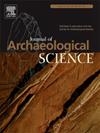资源和人口扩张对狩猎采集者男女蛋白质消费的影响
IF 2.5
1区 地球科学
Q1 ANTHROPOLOGY
引用次数: 0
摘要
本文研究了陆地与海洋资源和人口扩张对狩猎采集者蛋白质消耗性别差异的影响。我们认为,蛋白质消耗的差异出现在陆地资源更专业化和人口扩张的条件下。与这一假设相一致的是,接触前德克萨斯州的狩猎采集者在开发陆地和河流资源而不是沿海和河口资源时表现出更明显的δ15N同位素值的性别差异。此外,当觅食者收获陆地和河流资源时,δ15N同位素值的性别差异先下降后增加,与德克萨斯沿海平原人口扩张一致。在沿海生态系统中,随着种群的扩大,δ15N同位素值的性别差异仍然很小。这些模式支持了一种假设,即人口扩张和资源生产的相关变化可能会促使男性和女性的饮食生态位或多或少重叠。变化的方向取决于觅食者为扩大食物生产而选择的资源选择。本文章由计算机程序翻译,如有差异,请以英文原文为准。
The effects of resources and population expansion on female–male protein consumption among hunter-gatherers
This paper investigates the effects of terrestrial vs. marine resources and population expansion on sex differences in the consumption of protein among hunter-gatherers. We propose that differences in protein consumption emerge under conditions of greater specialization on terrestrial resources and population expansion. Consistent with this hypothesis, hunter-gatherers in pre-contact Texas display more pronounced sex differences in N isotope values when they exploit terrestrial and riverine resources rather than coastal and estuary resources. Further, where foragers harvest terrestrial and riverine resources, sex differences in N isotope values first decline and then increase coincident with population expansion on the Texas Coastal Plain. In coastal ecosystems, sex differences in N isotope values remain minimal as population expands. These patterns support the hypothesis that population expansion and associated changes in the production of resources may create incentives for more or less overlap in the dietary niches of males and females. The direction of change depends on the resource options that foragers select to scale-up their production of food.
求助全文
通过发布文献求助,成功后即可免费获取论文全文。
去求助
来源期刊

Journal of Archaeological Science
地学-地球科学综合
CiteScore
6.10
自引率
7.10%
发文量
112
审稿时长
49 days
期刊介绍:
The Journal of Archaeological Science is aimed at archaeologists and scientists with particular interests in advancing the development and application of scientific techniques and methodologies to all areas of archaeology. This established monthly journal publishes focus articles, original research papers and major review articles, of wide archaeological significance. The journal provides an international forum for archaeologists and scientists from widely different scientific backgrounds who share a common interest in developing and applying scientific methods to inform major debates through improving the quality and reliability of scientific information derived from archaeological research.
 求助内容:
求助内容: 应助结果提醒方式:
应助结果提醒方式:


